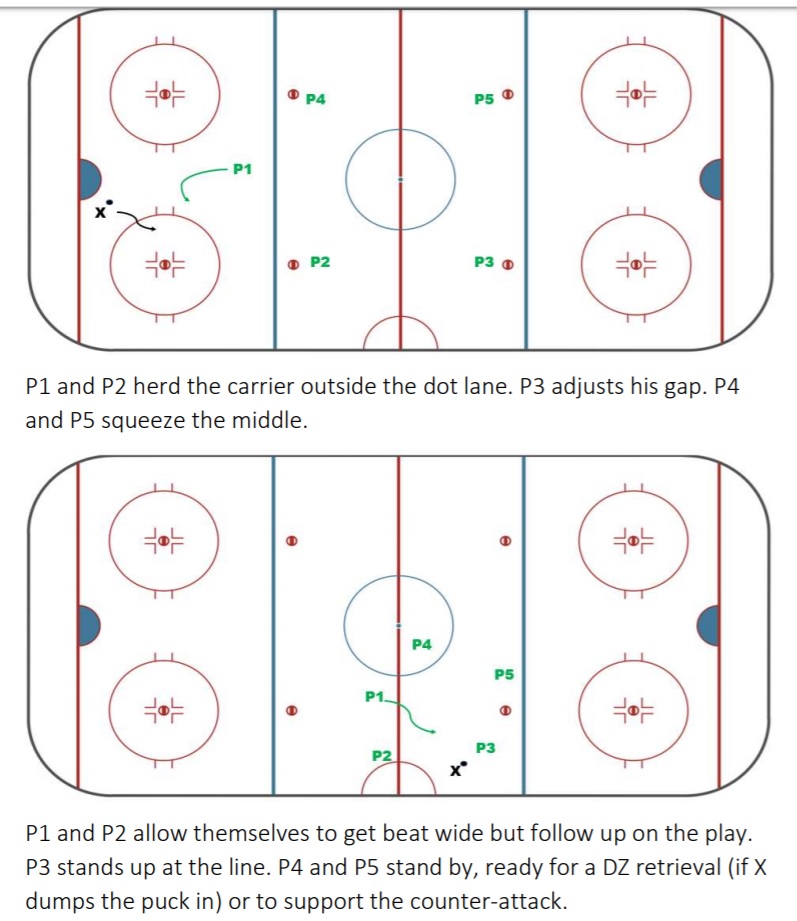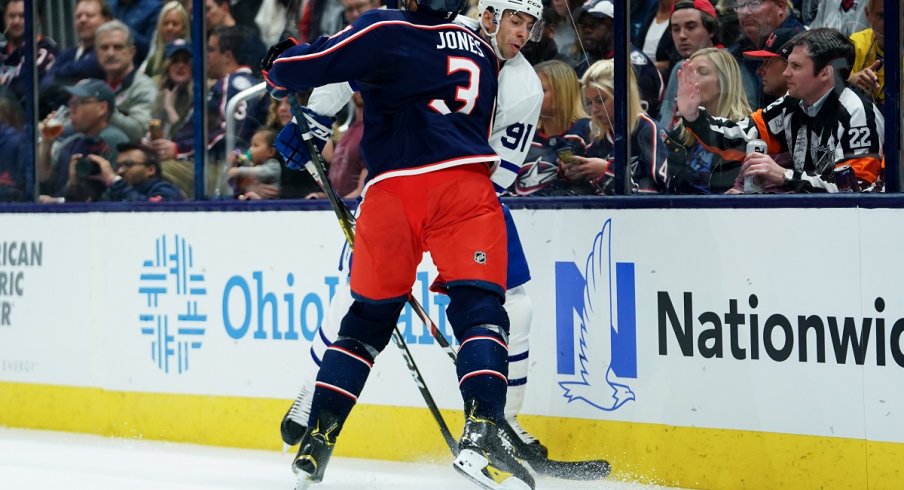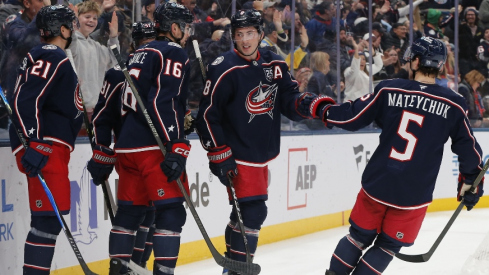Last week, we discussed how the Columbus Blue Jackets will plan to use arguably the NHL's most effective forecheck to turn the Toronto Maple Leafs miscues into offensive zone scoring chances and, ultimately, goals.
But the reality is that the majority of Maple Leafs zone exit attempts won't turn into goals or even scoring chances for the Blue Jackets. The flip side of that coin is that the Blue Jackets can use that same forecheck as a defensive tactic to also prevent quality scoring chances against.
Toronto is built similarly to the Tampa Bay Lightning team the Blue Jackets dispatched a year ago. Columbus found the Lightning's Achilles' heel by dramatically limiting chances off the rush. That carried over into this season. The Point Hockey's Mike Kelly pointed out in his video breakdown that the Blue Jackets give up the fewest even-strength rush goals of any team in the NHL at just 0.41 per game. That's impressive enough before accounting for the fact that this team lost 419 man-games to injury, most in the NHL.
Like most offensively gifted teams, the Maple Leafs thrive when given time and space. They can torch teams in transition. To quote The Athletic's Justin Bourne:
"CBJ gives up the least off the rush, which is Step 1 on the checklist to beating the Leafs. Toronto feasts on teams who let them fly through the neutral zone."
A friend of mine, Jack Han, who was previously (and recently) employed in the Maple Leafs organization both in the hockey operations department and more recently as an Assistant Coach with the AHL's Toronto Marlies, took my aforementioned article and offered a rebuttal as to how the Maple Leafs will overcome the Blue Jackets. In his post, he likened the Blue Jackets 1-2-2 forecheck to an icebreaker over frozen waters.
Before we get to Han's remedy for the Maple Leafs, here's a quick primer on the 1-2-2 forecheck, taken from a bonus chapter from his e-book Hockey Tactics 2020 (highly recommended). Player 1 (P1) pushes the puck carrier away from the middle of the ice. P2 and P3 converge, while P4 and P5 take away the middle and of the ice. It's not a unique system, it's just that the Blue Jackets have become more than proficient at speaking its language.

John Tortorella talks often about staying 'above the puck'. If you were to rotate the first diagram in the above image 90° counterclockwise (I didn't in order to preserve the text), you'd notice that P1 is "above" X, the puck carrier. Keeping five players above the puck is easier said than done, and there's a trade-off between generating offense and the number of players above the puck. In a vacuum, it's critical to simply have more players than the opposition above the puck in transition. Teams that fail to do so quickly become high risk for 2-on-1's and 3-on-2's against, which is obviously problematic. Conversely, playing in a total shell is a recipe for disaster, and is basically a way to postpone the inevitable goal against.
Does it make for the most wide-open and compelling hockey? No. Here's The Athletic's Aaron Portzline in an article earlier this week:
If the Blue Jackets find success against Toronto in the qualifying series, they can expect to be labeled “boring,” “bad for hockey,” “inglorious bastards” and the like.
And Han:
"I just don’t like the way CBJ plays. Telling your players to lock the game down and work their butt off just to ensure nothing of interest happens for either team is no way to elevate hockey."
Here are some video examples of the Blue Jackets doing an excellent job staying above the puck, preventing their opponent from creating offense:
And here are some video examples of the Blue Jackets' forecheck failing to squash the opposition's attack in transition:
After breaking down the Blue Jackets final game before the pause, against the Vancouver Canucks, here is Han's answer to sinking the Columbus icebreaker:
"Toronto should do a better job than Vancouver. They’ll have to find the correct solutions to beat F1 (deception, stiff-arm, skate away), mix vertical and lateral passing to get through the NZ (2 over, 1 up, or a variation thereof), then take advantage of CBJ’s sagging Dmen (Jones, Savard, etc.) to capitalize off the rush."
It's true that the Blue Jackets are more icebreaker than they are a speedboat. That designation would belong to Toronto. But that won't bother Columbus, who knows this is how they'll have to play to find success. When Portzline caught up with Tortorella to discuss the upcoming series, Tortorella had this to say:
“You look at Toronto, they’re filled with offensive people very similar (to) our first-round opponent last year in Tampa. We have to be in the proper mindset of doing the dirty work and the mental part of it as far as being ‘above’ the puck all the time.
We talk about it every day, working off transition. If we get lazy and cheat a little bit and stay ‘under’ the puck and hope we get it back in the offensive zone to score those types of goals, we’re going to be in trouble. This team (Toronto) is too good offensively, and they’ll capitalize on those things.”
I argued a few weeks ago that scoring the first goal will be crucial for both teams. If the Blue Jackets hold a lead, their 1-2-2 forecheck becomes even more effective. It's good at creating offense, yes, but it's gravy. More importantly, it's difficult to penetrate. If Toronto holds a lead, the Blue Jackets will likely eventually have to adjust to become more aggressive in their forecheck style. This opens them up to more chances against, which becomes either a self-fulfilling prophecy or a risky but worthwhile gamble, depending on the final outcome.
The Maple Leafs know that the Blue Jackets will deploy the 1-2-2 forecheck and will remain precise and disciplined in staying above the puck. If the Blue Jackets can frustrate Toronto like they did the Lightning last spring, it could mean a similar result.


